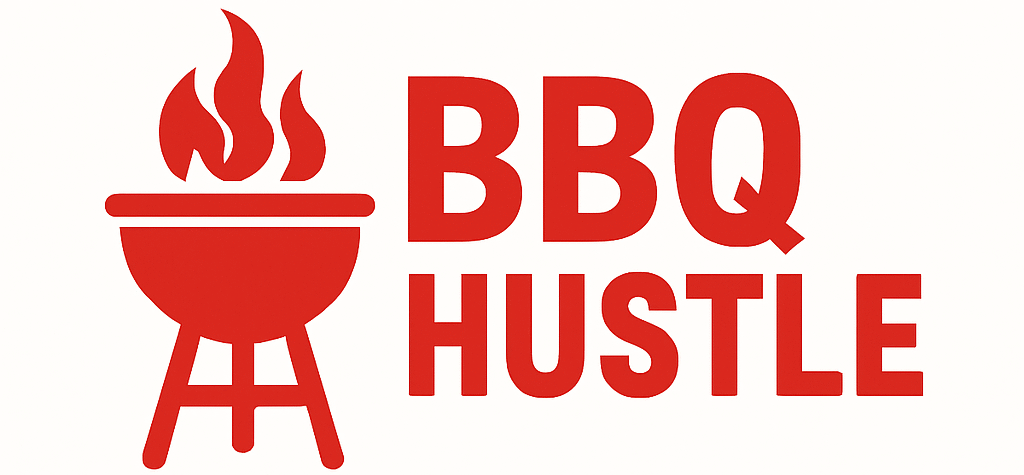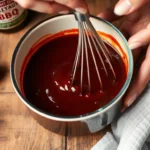There’s nothing quite like the aroma of slow-cooked pork filling your kitchen as tender meat transforms into mouthwatering barbecue pulled pork. This Southern comfort food classic has become a backyard favorite across America, and we’re about to show you why it deserves a permanent spot on your dinner rotation.
Our foolproof barbecue pulled pork recipe delivers restaurant-quality results right from your own kitchen. We’ve perfected the art of creating fall-apart tender pork that practically shreds itself, paired with a rich smoky flavor that’ll have your family asking for seconds before they’ve finished their first serving.
Whether you’re feeding a crowd at your next cookout or simply craving that authentic barbecue taste, this recipe requires minimal hands-on time while delivering maximum flavor. We’ll walk you through every step to ensure your pulled pork turns out perfectly seasoned and incredibly juicy every single time.
Ingredients
Our barbecue pulled pork recipe requires carefully selected ingredients that work together to create layers of smoky flavor and tender texture. We’ve organized the ingredients into three essential categories to help you prepare this crowd-pleasing dish.
For the Pork
- 4-5 pounds pork shoulder (Boston butt), bone-in or boneless
- 2 tablespoons olive oil
- 1 large yellow onion, sliced thick
- 1 cup apple cider vinegar
- 1/2 cup beef broth
- 2 bay leaves
For the Dry Rub
- 2 tablespoons brown sugar, packed
- 2 tablespoons paprika
- 1 tablespoon chili powder
- 1 tablespoon garlic powder
- 1 tablespoon onion powder
- 1 teaspoon ground cumin
- 1 teaspoon smoked paprika
- 1 teaspoon salt
- 1/2 teaspoon black pepper
- 1/2 teaspoon cayenne pepper
For the Barbecue Sauce
- 1 cup ketchup
- 1/4 cup apple cider vinegar
- 1/4 cup brown sugar, packed
- 2 tablespoons Worcestershire sauce
- 2 tablespoons yellow mustard
- 1 tablespoon molasses
- 1 teaspoon liquid smoke
- 1 teaspoon garlic powder
- 1/2 teaspoon onion powder
- 1/4 teaspoon cayenne pepper
- Salt and black pepper to taste
Equipment Needed

Creating exceptional barbecue pulled pork requires the right tools to achieve tender, flavorful results. We recommend selecting equipment based on your preferred cooking method and experience level.
Primary Cooking Equipment
Smoker remains our top choice for authentic barbecue pulled pork with genuine smoky flavor. Several smoker types deliver excellent results:
- Pellet smokers offer the best option for beginners due to automatic pellet feeding and precise temperature control
- Charcoal smokers provide traditional smoky flavor with hands-on involvement
- Electric smokers maintain steady heat with minimal effort
- Wood-fired smokers deliver classic smoky taste for experienced pitmasters
Popular pellet smoker brands include Traeger Grills Pro 34, Rec-Tec, and Yoders Smoker for consistent performance.
Slow Cooker serves as an excellent alternative for convenient, hands-off braising. This method produces tender pulled pork without requiring constant temperature monitoring.
Dutch Oven or Roasting Pan works perfectly for oven cooking methods. We use these tools for low-temperature slow cooking that results in incredibly tender meat.
Essential Accessories
Meat thermometer ensures your pork reaches the ideal internal temperature for perfect pulling texture. Accurate temperature readings prevent overcooking or undercooking.
Basting brush allows even application of barbecue sauce during the final cooking stages.
Tongs and forks provide the necessary tools for shredding the cooked pork into perfect pulled pork texture.
Toasted buns or serving plates complete your barbecue pulled pork presentation.
| Equipment Type | Best For | Key Benefit |
|---|---|---|
| Pellet Smoker | Beginners | Automatic temperature control |
| Charcoal Smoker | Traditional flavor | Authentic smoky taste |
| Slow Cooker | Convenience | Hands-off cooking |
| Dutch Oven | Indoor cooking | Consistent oven results |
These tools enable us to prepare barbecue pulled pork through smoking for authentic flavor or slow cooking methods for convenience, both delivering tender, juicy results ready for serving.
Prep Instructions
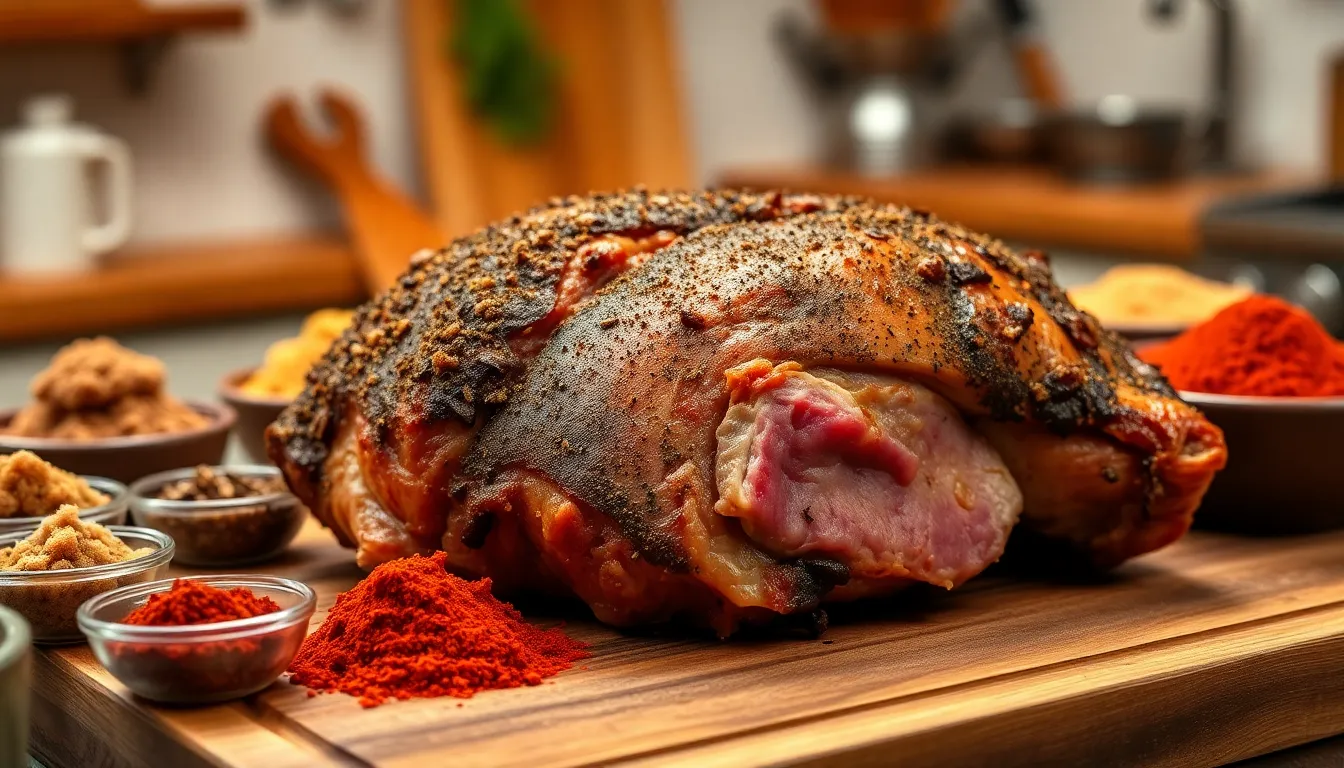
Proper preparation sets the foundation for exceptional barbecue pulled pork. We’ll walk through each crucial step to ensure our pork develops maximum flavor and achieves that perfect tender texture.
Preparing the Pork Shoulder
We start with our 4 to 5-pound pork shoulder and remove excess fat while keeping some for moisture and flavor retention. Sharp kitchen shears work best for trimming the fat cap to about ¼ inch thickness. Our pork needs to fit comfortably in the cooking vessel, so we cut larger shoulders into manageable pieces if necessary.
Creating deep slits across the surface allows us to insert garlic slices for enhanced flavor penetration throughout the meat. We make these cuts about 1 inch deep and 2 inches apart in a crosshatch pattern. Optional searing adds depth to our final flavor profile, so we heat olive oil in a heavy pan and brown all surfaces for approximately 2 minutes per side until golden.
Making the Dry Rub
Our dry rub combines perfectly balanced spices that create the signature barbecue flavor. We mix 2 tablespoons brown sugar with 1 tablespoon each of paprika and chili powder in a medium bowl. Ground cumin, garlic powder, and onion powder each contribute 1 teaspoon to our blend.
Salt and black pepper form the seasoning base with 1 teaspoon each added to the mixture. Smoked paprika enhances the authentic barbecue taste while cayenne pepper provides optional heat according to preference. We whisk all ingredients thoroughly to ensure even distribution and store any leftover rub in an airtight container for future use.
| Spice | Amount |
|---|---|
| Brown sugar | 2 tablespoons |
| Paprika | 1 tablespoon |
| Chili powder | 1 tablespoon |
| Garlic powder | 1 teaspoon |
| Onion powder | 1 teaspoon |
| Ground cumin | 1 teaspoon |
| Salt | 1 teaspoon |
| Black pepper | 1 teaspoon |
| Smoked paprika | ½ teaspoon |
| Cayenne pepper | ¼ teaspoon (optional) |
Applying the Rub
We generously coat the entire pork shoulder with our dry rub mixture, working it into every crevice and surface. Clean hands provide the best control for massaging the spices deep into the meat fibers. Extra attention to the scored areas ensures the rub penetrates where we made our slits.
Timing matters for optimal flavor development, so we apply the rub at least 2 hours before cooking or preferably overnight in the refrigerator. Wrapping the seasoned pork in plastic wrap prevents the rub from transferring to other foods while allowing the flavors to meld. Room temperature resting for 30 minutes before cooking helps ensure even heat distribution throughout the cooking process.
Cooking Instructions
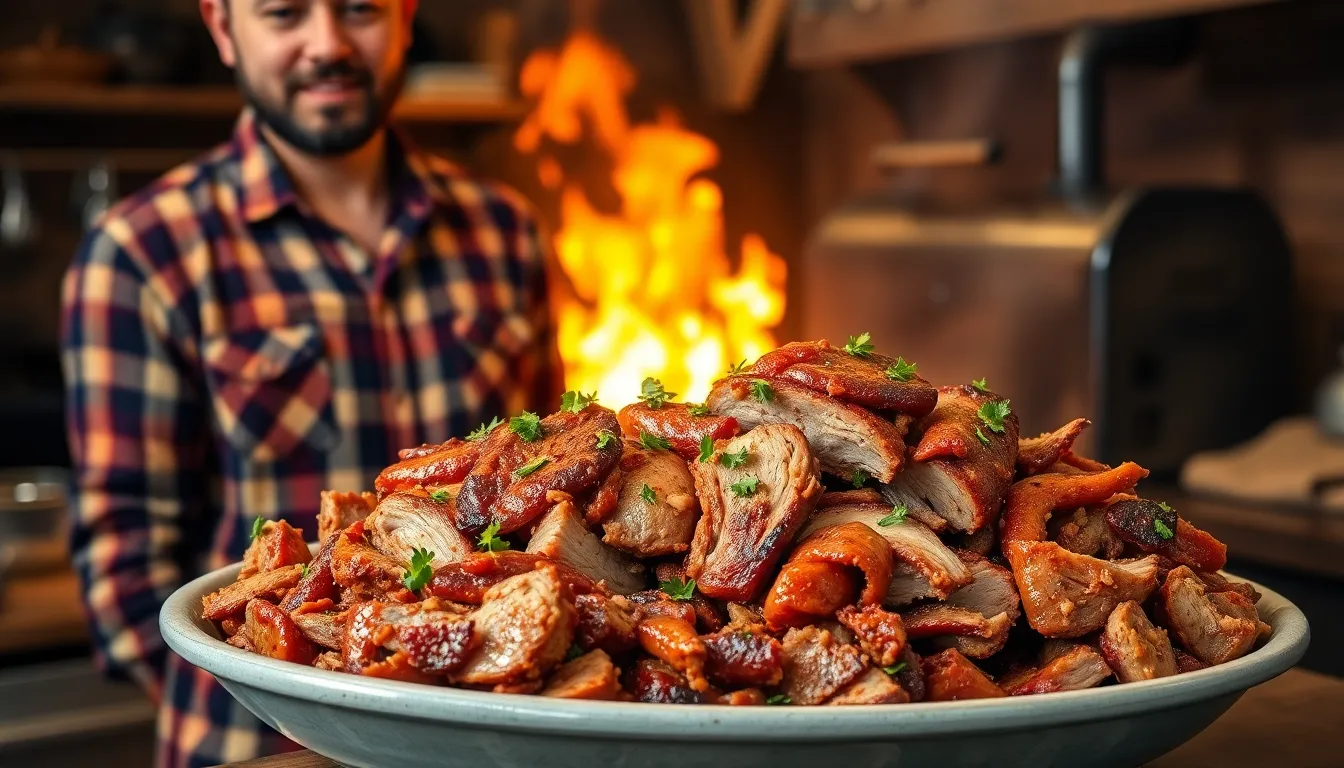
We’ll guide you through three proven cooking methods that deliver exceptional barbecue pulled pork. Each technique offers unique advantages while ensuring tender and flavorful results.
Oven Method
We begin by preheating our oven to 300°F for optimal slow cooking conditions. Optional searing in a Dutch oven with 2 tablespoons of oil creates a beautiful crust and deeper flavor profile on all sides of the pork pieces.
Place the seasoned pork in the Dutch oven and pour 12 ounces of light beer or coke around the meat. Cover tightly with a lid and transfer to the preheated oven for 3 hours of initial cooking.
Remove the lid after 3 hours and continue cooking for an additional 1 to 2 hours. The pork reaches perfect doneness when it shreds easily with two forks and has developed a beautiful caramelized exterior.
Slow Cooker Method
We place our prepared pork pieces directly into the slow cooker for this hands-off approach. Pour your choice of liquid over the pork: 12 ounces of coke or light beer works wonderfully as a braising liquid.
For enhanced flavor complexity we recommend combining beer with 2 tablespoons soy sauce, 1 tablespoon apple cider vinegar, and 1 teaspoon sesame oil. Cover the slow cooker and set to LOW for 8 to 10 hours or HIGH for 4 to 5 hours.
The pork becomes perfectly tender when it falls apart at the touch of a fork. Shred the cooked pork directly in the slow cooker and mix with your favorite barbecue sauce before serving.
Smoker Method
We prepare our smoker to maintain a steady temperature between 225°F and 250°F for authentic barbecue flavor. Place the seasoned pork shoulder directly on the smoker grates with the fat cap facing up.
Smoke the pork for approximately 1.5 to 2 hours per pound until the internal temperature reaches 195°F to 205°F. During the final cooking stages we recommend wrapping the pork in foil to retain moisture and prevent over-browning.
Allow the smoked pork to rest for 15 to 20 minutes before shredding. This resting period ensures the juices redistribute throughout the meat for maximum tenderness and flavor.
Making the Barbecue Sauce
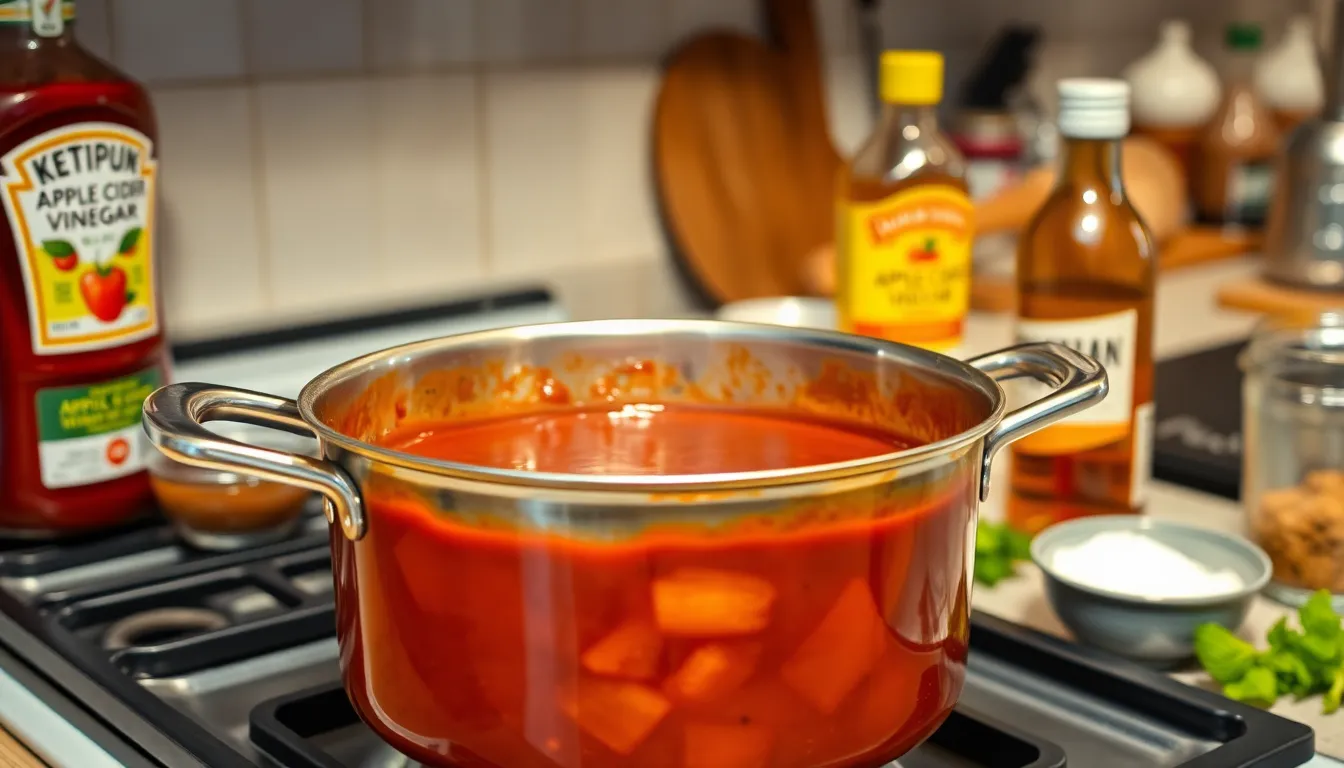
We believe homemade barbecue sauce elevates pulled pork from good to exceptional. Creating our own sauce allows us to control sweetness levels and adjust the tang to perfectly complement the smoky pork flavors.
Starting with the base ingredients ensures a well-balanced sauce that enhances rather than masks the meat’s natural taste. We combine 1 cup ketchup with ¼ cup apple cider vinegar in a medium saucepan over medium heat. The ketchup provides the tomato foundation while apple cider vinegar adds essential tang that cuts through rich pork fat.
Brown sugar or molasses adds crucial sweetness to balance the acidity. We whisk in ¼ cup brown sugar until completely dissolved. For deeper molasses flavor we substitute 2 tablespoons molasses for half the brown sugar.
Building complexity requires layering additional flavors throughout the cooking process. We stir in 2 tablespoons Worcestershire sauce and 1 tablespoon yellow mustard. Worcestershire sauce contributes umami depth while mustard provides subtle heat and helps emulsify the mixture.
Spice additions transform basic ingredients into restaurant-quality barbecue sauce. We add 1 teaspoon each of garlic powder and onion powder along with ½ teaspoon smoked paprika. Chili powder brings warmth without overwhelming heat.
Optional ingredients allow us to customize the sauce to personal preferences. We include ¼ teaspoon liquid smoke for enhanced smokiness when cooking indoors. Hot sauce adjusts spice levels according to taste preferences.
Simmering develops flavors and achieves proper consistency for coating pulled pork. We bring the mixture to a gentle boil then reduce heat to low. The sauce simmers for 10 to 15 minutes until it coats the back of a spoon.
Taste testing ensures perfect balance between sweet tangy and spicy elements. We adjust brown sugar for sweetness vinegar for tang and hot sauce for heat. The finished sauce should complement rather than overpower the seasoned pork.
Storage options keep homemade barbecue sauce fresh for multiple uses. We transfer cooled sauce to airtight containers and refrigerate for up to two weeks. The sauce also freezes well for up to three months in portion-sized containers.
Shredding and Finishing
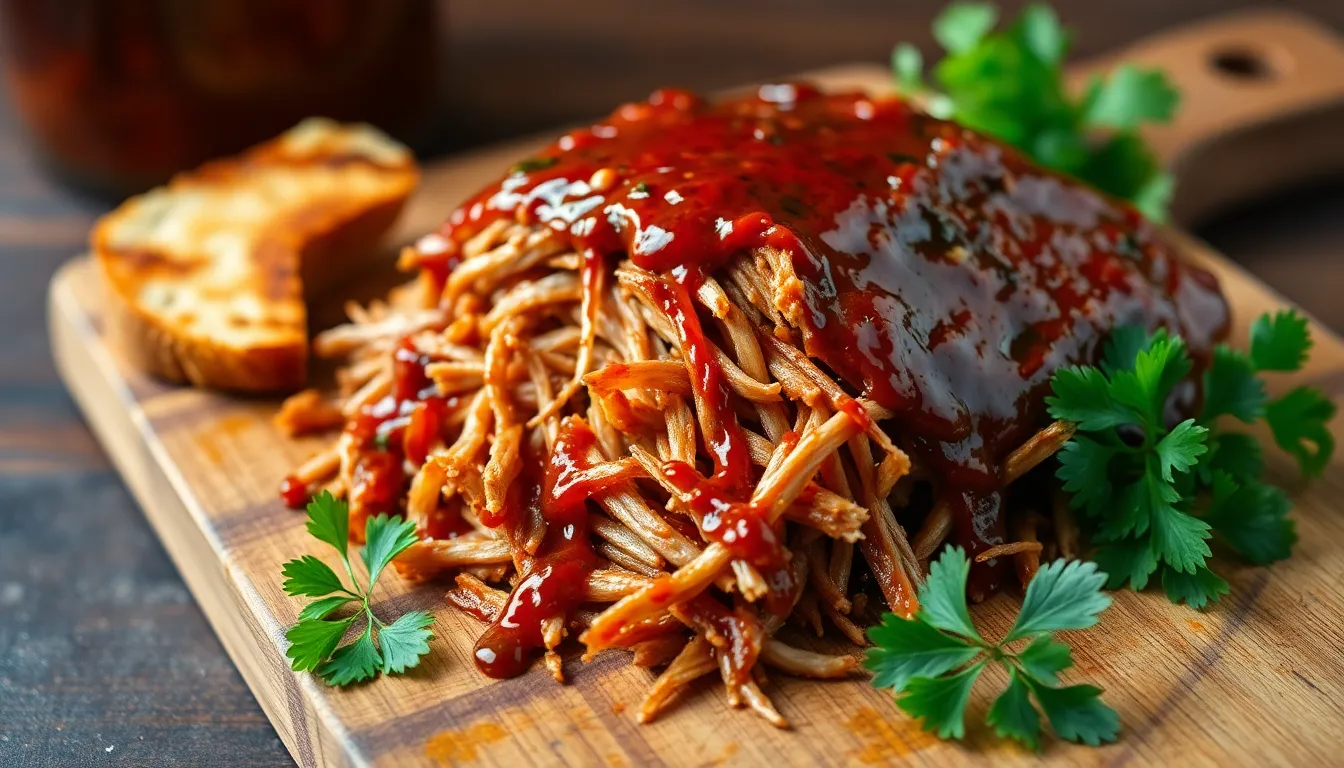
The final transformation from cooked pork shoulder to restaurant-quality pulled pork happens during the shredding and finishing process. We’ll guide you through the proper techniques to achieve tender strands perfectly coated with barbecue sauce.
How to Properly Shred the Pork
Once our pork shoulder reaches that perfect fall-apart tenderness after slow cooking, we need to remove it from the cooking vessel immediately. Transfer the hot pork to a clean cutting board or large plate and allow it to rest briefly before handling.
We recommend using two forks or sturdy tongs to pull the meat apart into bite-sized shreds. The collagen that has broken down during our long cooking process makes this task surprisingly easy. Start at one end of the pork shoulder and gently pull the meat in opposite directions with our forks.
Resist the temptation to shred the pork while it’s still in the hot cooking liquid. This brief resting period helps the meat retain its natural juices and prevents us from over-mixing or breaking down the texture too much. The meat should practically fall apart in our hands when properly cooked.
Work systematically through the entire pork shoulder, removing any remaining fat or connective tissue as we encounter it. We want consistent, manageable pieces that will hold up well in sandwiches or serve beautifully as a main dish.
Mixing with Sauce
After shredding our pork completely, we return it to either the slow cooker, Dutch oven, or transfer it to a large mixing bowl. Add our reserved cooking juices or prepared barbecue sauce gradually to avoid oversaturating the meat.
Gently toss the shredded pork with the sauce using large spoons or clean hands to ensure even coating. Our homemade barbecue sauce contains the perfect balance of ketchup, mustard, vinegar, brown sugar, and Worcestershire sauce that enhances both moisture and flavor without making the meat soggy.
We prefer to simmer our barbecue sauce separately before mixing to ensure optimal flavor integration. This technique allows us to control the consistency and taste of our final product more precisely. Add sauce gradually until we achieve our desired level of moisture and flavor intensity.
The sauce should coat each strand of pork without pooling at the bottom of our container. Mix thoroughly but gently to maintain the meat’s tender texture while ensuring every bite delivers that signature barbecue flavor we’ve worked so hard to develop.
Serving Suggestions

Our perfectly shredded pulled pork transforms into countless delicious meals that satisfy every craving. We’ll show you the most popular ways to serve this barbecue masterpiece for maximum enjoyment.
Classic Sandwich Style
We recommend serving pulled pork on toasted hamburger buns or soft sandwich rolls for the ultimate barbecue experience. The contrast between the tender meat and crispy bread creates an irresistible texture combination that keeps everyone coming back for more.
Topping the pulled pork with coleslaw adds essential crunch and tangy flavor that balances the rich smokiness of the meat. We suggest using either creamy coleslaw or vinegar-based slaw depending on your preference for acidity levels.
Pickles and extra barbecue sauce on the side allow guests to customize their sandwiches according to their taste preferences. These additions provide bright acidity and additional moisture that complement the savory pork perfectly.
This serving style proves especially popular for casual gatherings, backyard barbecues, and game day meals where guests appreciate handheld convenience without sacrificing flavor.
Side Dish Pairings
We’ve identified the perfect side dishes that enhance pulled pork’s smoky and savory profile while providing contrasting textures and refreshing elements.
Classic coleslaw remains our top recommendation whether you prefer creamy or vinegar-based varieties. The crisp cabbage and carrots provide essential freshness that cuts through the rich pork fat.
Cornbread or warm biscuits serve as ideal vessels for soaking up barbecue sauce while adding comforting carbohydrates to the meal. We suggest serving them warm with honey butter for extra indulgence.
Baked beans or smoky beans create a harmonious flavor pairing since both dishes share similar barbecue seasonings and cooking methods. The beans add protein and fiber while maintaining the meal’s rustic appeal.
Macaroni and cheese brings creamy richness that complements the smoky meat without competing for attention. We recommend using sharp cheddar for the best flavor balance.
Potato salad or roasted potatoes provide satisfying starch that helps balance the meal’s overall composition. Both options offer different textures while absorbing the delicious barbecue flavors.
Grilled corn on the cob adds natural sweetness and seasonal appeal during summer months. The charred kernels echo the smoky cooking method used for the pork.
Fresh pickles and crisp salads introduce bright acidity and clean flavors that refresh the palate between bites of rich pulled pork. These lighter options prevent flavor fatigue during larger meals.
Storage and Reheating
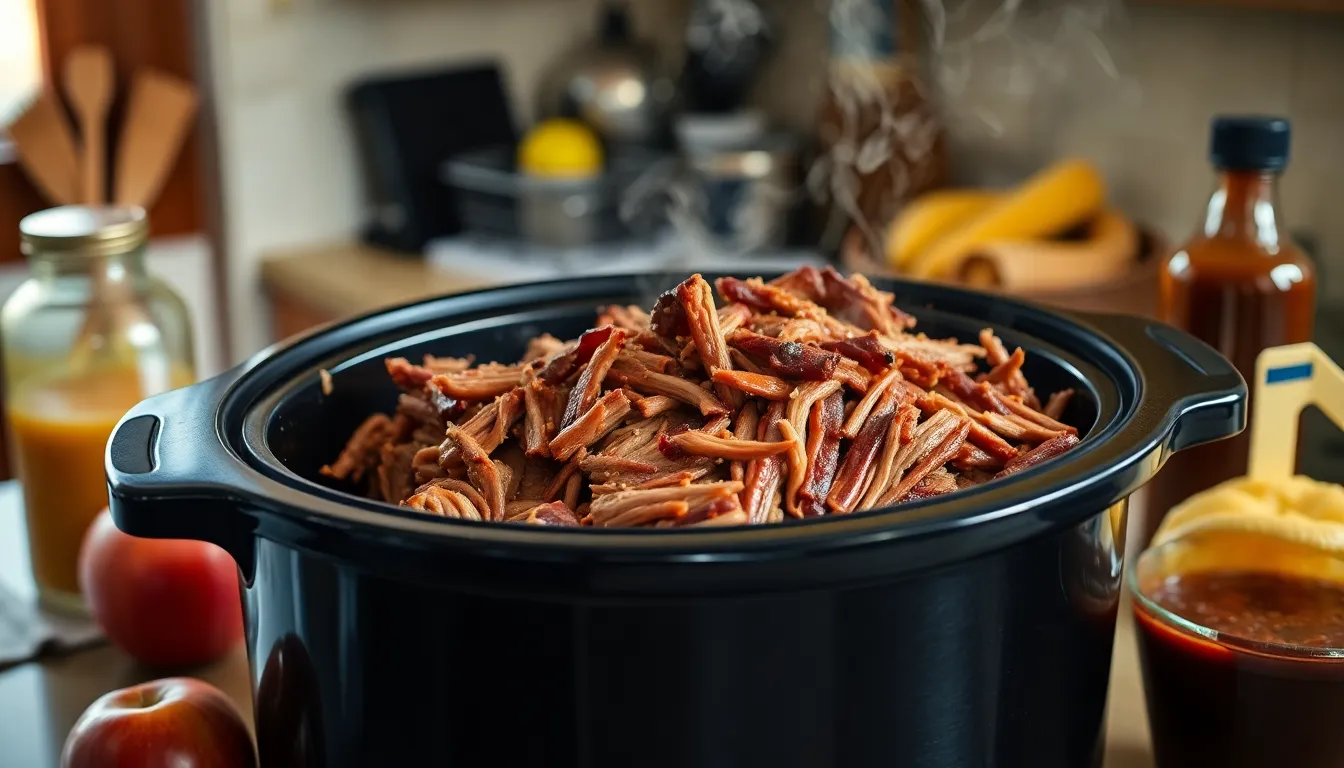
Our barbecue pulled pork tastes just as incredible the next day when stored and reheated properly. These proven techniques ensure our leftover pulled pork maintains its tender texture and bold flavors.
Make-Ahead Instructions
We can prepare our pulled pork entirely ahead of time for maximum convenience. Cook the pork shoulder completely using any preferred method then allow it to cool slightly before transferring to airtight containers or zip-top bags.
Store the pork whole rather than shredded when possible since this retains significantly more moisture and prevents dryness during reheating. We recommend keeping the cooked pork butt intact in the refrigerator and shredding only after reheating for the best results.
Prepare our homemade barbecue sauce separately and store it in the refrigerator for up to one week. This allows us to add fresh sauce during reheating which enhances both flavor and moisture content.
When ready to serve we can reheat the pork gently using several effective methods. Place the pulled pork in a slow cooker with a splash of barbecue sauce, apple juice, or beef broth then set to warm for 2 to 4 hours. For smaller portions we can use ceramic ramekins with a tablespoon of BBQ sauce and reheat in an air fryer at 320°F for about 6 minutes.
Alternatively we can reheat in a covered pan with apple juice, broth, or even Coke at a low oven temperature around 200-250°F. This gentle reheating prevents the meat from drying out while maintaining its signature tenderness.
Freezing Guidelines
Our pulled pork freezes exceptionally well when packaged correctly. Vacuum seal the cooked pork or wrap tightly in freezer-safe bags to prevent freezer burn and off flavors from developing.
Portion the meat into meal-sized servings before freezing for ultimate convenience. This allows us to thaw only what we need without repeatedly exposing the entire batch to temperature changes.
| Freezing Method | Storage Time | Thawing Instructions |
|---|---|---|
| Vacuum sealed bags | Up to 6 months | Submerge sealed bag in boiling water 5-10 minutes |
| Freezer-safe containers | Up to 3 months | Thaw overnight in refrigerator |
| Zip-top freezer bags | Up to 4 months | Place sealed bag in warm water bath |
To reheat frozen pulled pork we place the sealed bag directly in boiling water for 5-10 minutes until heated through. Transfer the warmed pork to a slow cooker or covered pan with additional moisture like barbecue sauce or broth for the final reheating process.
Proper packaging and gentle thawing techniques ensure our frozen pulled pork stays incredibly juicy and tender even months after the initial cooking. We avoid multiple reheating cycles to maintain food safety and preserve the meat’s exceptional quality.
Tips for Perfect Pulled Pork
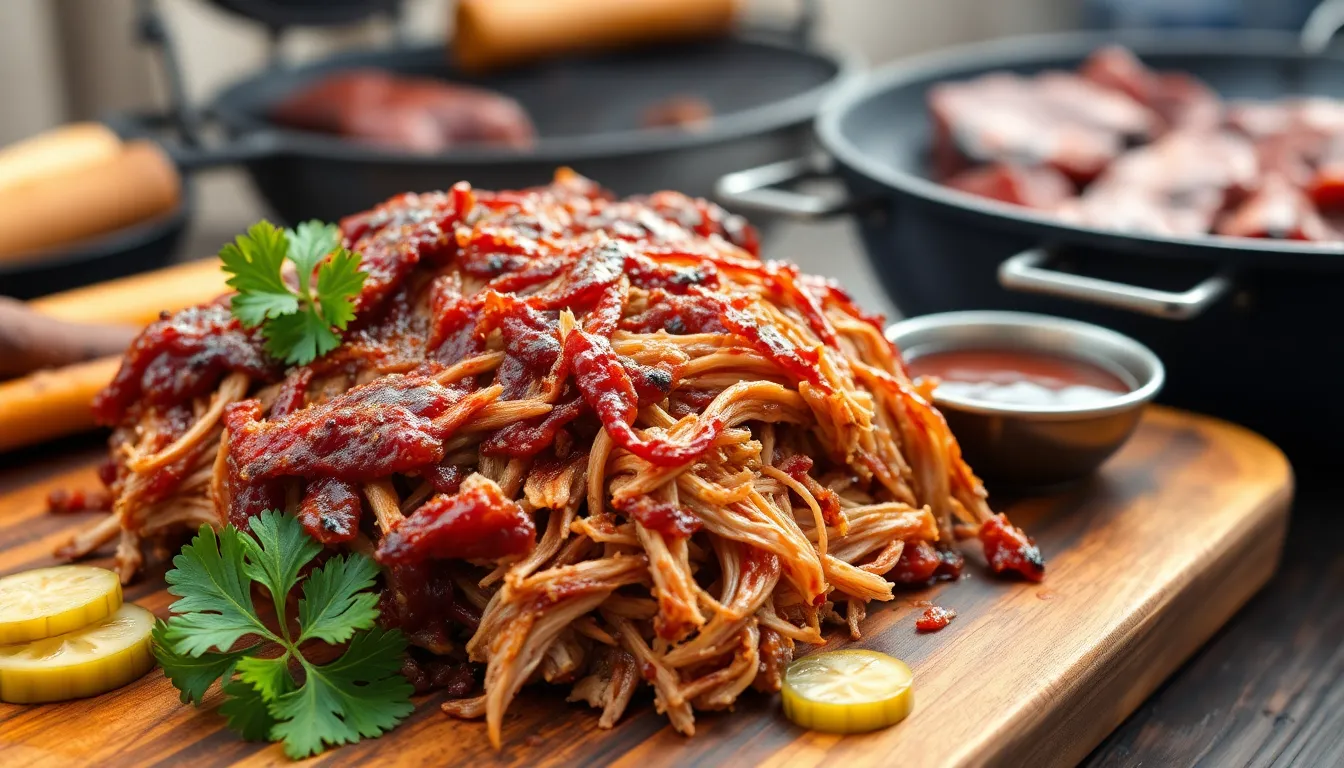
We’ve discovered that mastering a few key techniques transforms ordinary pork shoulder into extraordinary barbecue pulled pork. Our experience shows that selecting well-marbled pork shoulder ensures optimal tenderness and flavor development throughout the cooking process.
Choose the Right Cut and Preparation
Pork butt delivers superior results compared to other cuts due to its high fat content and connective tissue. We recommend studding the meat with garlic cloves by making deep slits throughout the surface. This technique infuses aromatic flavor deep into the meat fibers during the long cooking process.
Master the Dry Rub Application
Applying our dry rub the night before cooking enhances flavor penetration significantly. We create deep flavor layers by generously coating every surface of the pork shoulder. The rub should include brown sugar for caramelization along with chili powder, onion powder, garlic powder, cumin, kosher salt, and black pepper for complexity.
Temperature Control Creates Tenderness
Slow, low-temperature cooking breaks down tough connective tissue into gelatin that keeps the meat juicy and tender. We maintain temperatures between 225°F to 300°F depending on our chosen cooking method. Internal temperature should reach 195°F to 205°F for proper shredding consistency.
Enhance Flavor with Acidic Liquids
Adding acidic components like apple cider vinegar or cola helps tenderize the meat while balancing rich flavors. We often use beer, liquid smoke, or even soy sauce as braising liquids to create complex flavor profiles. These liquids also prevent the meat from drying out during extended cooking times.
Optional Searing for Depth
Browning the pork before slow cooking adds deeper flavor complexity through the Maillard reaction. We sear all surfaces in a hot pan with oil until golden brown. This step creates a flavorful crust that enhances the overall taste profile of our finished pulled pork.
Perfect the Shredding Technique
Proper shredding requires patience and the right approach. We allow the cooked pork to rest for 15 minutes before handling to retain natural juices. Using two forks or tongs, we pull the meat apart following the natural grain into bite-sized strands.
Control Sauce Integration
Mixing pulled pork with barbecue sauce requires balance to avoid oversaturation. We prefer serving sauce on the side initially, allowing each person to customize their preferred moisture level. When mixing sauce directly, we add it gradually while tossing to achieve even coating.
| Cooking Method | Temperature | Time Range | Internal Temp |
|---|---|---|---|
| Slow Cooker | Low Setting | 8-10 hours | 195-205°F |
| Oven | 300°F | 3-5 hours | 195-205°F |
| Smoker | 225°F | 1.5-2 hours/lb | 195-205°F |
| Instant Pot | High Pressure | 70 minutes | 195-205°F |
Storage and Reheating Strategies
We store leftover pulled pork properly to maintain its tender texture for future meals. Refrigerated pulled pork stays fresh for up to one week when stored in airtight containers. Freezing extends storage life to several months when vacuum sealed or stored in freezer-safe containers with minimal air exposure.
Conclusion
We’ve shared everything you need to create mouthwatering barbecue pulled pork that’ll have your family and friends coming back for seconds. This recipe delivers authentic smokehouse flavors without requiring professional equipment or years of experience.
The beauty of this dish lies in its flexibility – whether you’re using a smoker for that traditional taste or opting for the convenience of a slow cooker our methods guarantee tender juicy results every time. The homemade barbecue sauce and carefully balanced dry rub transform simple pork shoulder into something truly special.
Now it’s time to fire up your cooking equipment and experience the satisfaction of creating restaurant-quality pulled pork in your own kitchen. Trust us – once you master this recipe you’ll never want to buy pulled pork from anywhere else again.
Frequently Asked Questions
What cut of pork is best for pulled pork?
Pork shoulder (also called Boston butt) is the ideal cut for pulled pork. This cut contains the perfect amount of marbling and connective tissue that breaks down during slow cooking, resulting in tender, juicy meat that shreds easily. A 4-5 pound pork shoulder will feed 8-10 people generously.
How long does it take to cook pulled pork?
Cooking time varies by method. In a 300°F oven, cook for 3-5 hours. Slow cooker takes 8-10 hours on low or 4-5 hours on high. Smoker requires 1.5-2 hours per pound at 225-250°F. Instant Pot cooks it in 70 minutes under high pressure.
What temperature should pulled pork reach when done?
Pulled pork is perfectly done when it reaches an internal temperature of 195-205°F. At this temperature, the connective tissue has fully broken down, making the meat tender enough to shred easily. Use a meat thermometer to ensure accuracy and food safety.
Can I make pulled pork without a smoker?
Absolutely! You can make excellent pulled pork using a slow cooker, Dutch oven, or regular oven. While these methods won’t provide the same smoky flavor as a traditional smoker, adding liquid smoke to your barbecue sauce helps replicate that authentic barbecue taste.
How far in advance should I apply the dry rub?
Apply the dry rub at least 2 hours before cooking, but ideally the night before. This allows the spices to penetrate deeper into the meat, developing more complex flavors. The salt in the rub also helps draw out moisture, creating a better crust during cooking.
What’s the best liquid for braising pulled pork?
Apple cider vinegar, beef broth, beer, or even cola work excellently as braising liquids. These liquids add flavor while keeping the meat moist during cooking. The acidity in vinegar or cola also helps tenderize the meat and balances the rich pork flavors.
How do I prevent pulled pork from drying out?
Keep the pork covered during cooking and don’t overcook it. Save the cooking juices to mix back into the shredded meat. Store leftovers with some sauce or cooking liquid, and reheat gently using low temperatures to maintain moisture.
Can I freeze pulled pork?
Yes, pulled pork freezes well for up to 3 months. Store it in vacuum-sealed bags or airtight containers with some cooking liquid or sauce. Thaw overnight in the refrigerator and reheat gently in a slow cooker or low oven to maintain texture.
What are the best side dishes for pulled pork?
Classic sides include coleslaw, cornbread, baked beans, and macaroni and cheese. Fresh options like potato salad, grilled corn, and garden salads provide refreshing contrasts to the rich pork. These sides complement the smoky, savory flavors while adding textural variety.
How long does homemade barbecue sauce last?
Homemade barbecue sauce stays fresh in the refrigerator for up to one week when stored in an airtight container. For longer storage, you can freeze the sauce for up to 3 months. Always use clean utensils when serving to prevent contamination.
